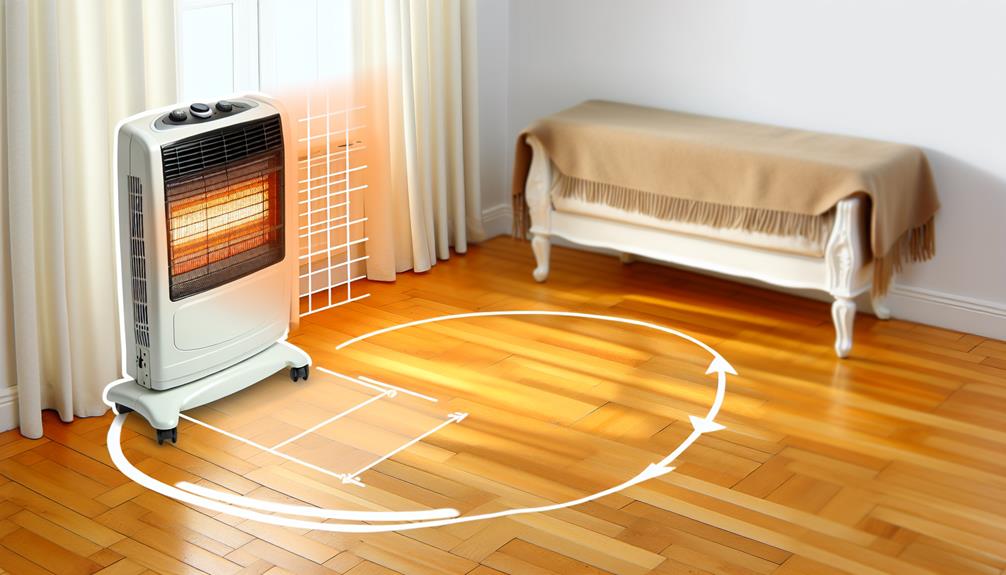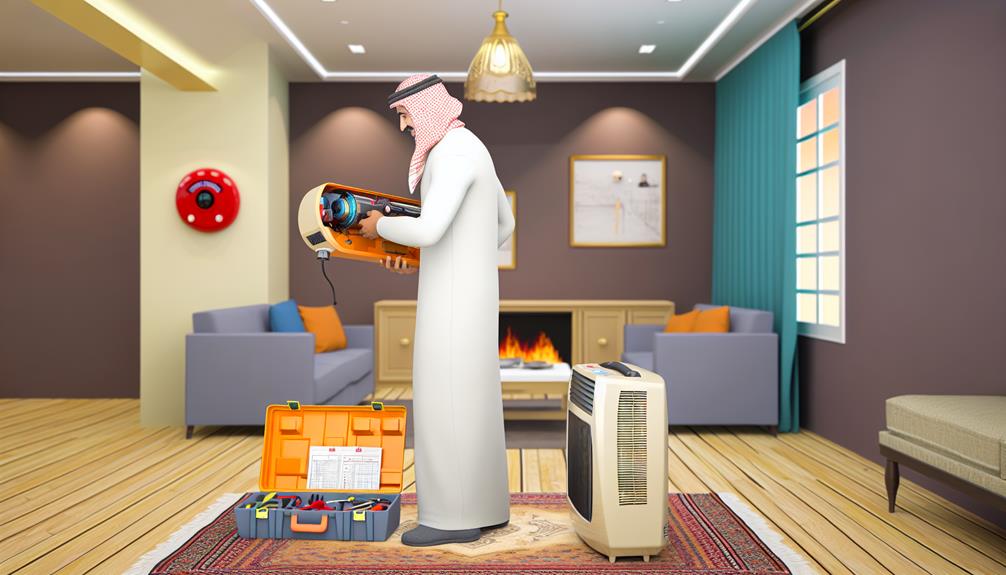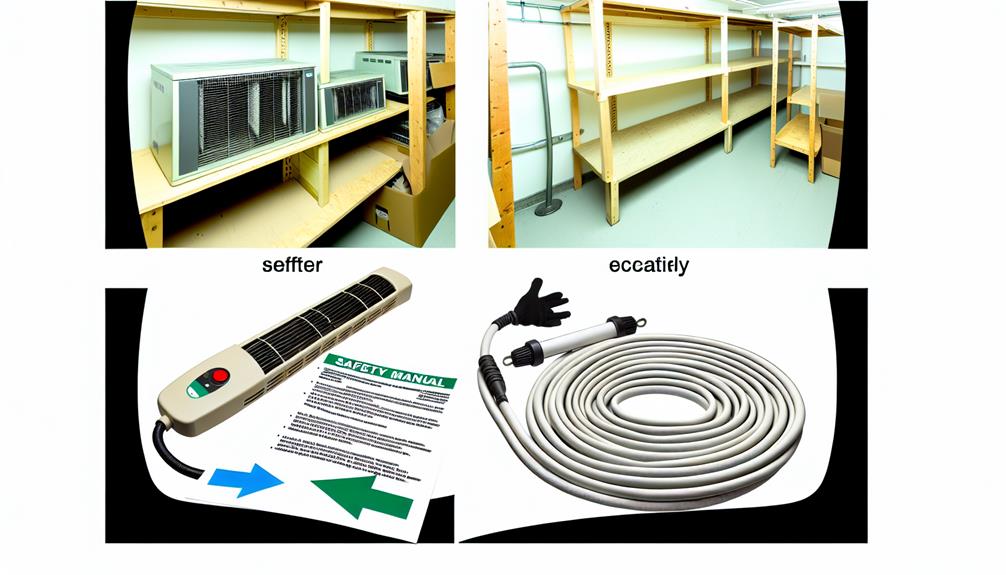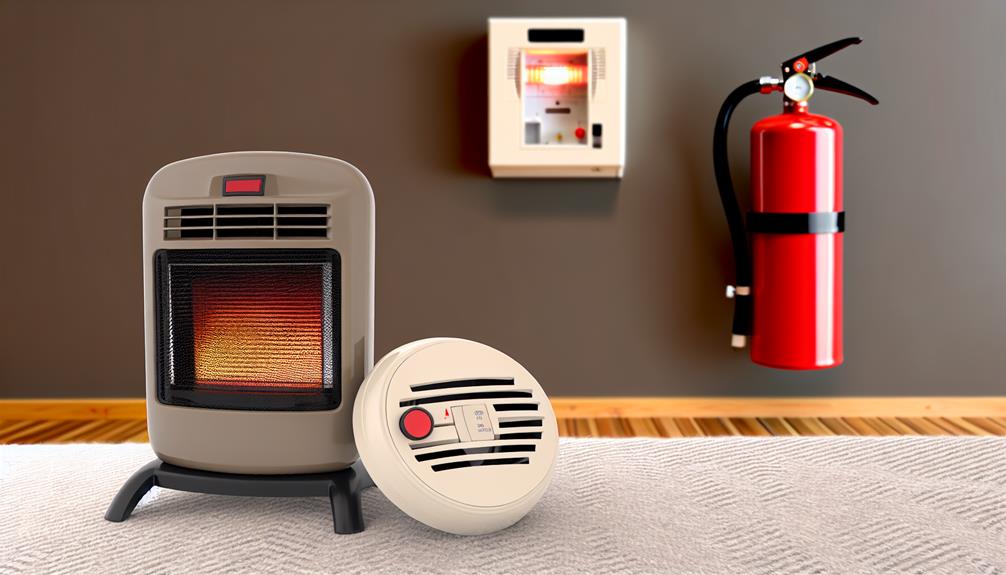Just as Icarus was warned not to fly too close to the sun, you need to exercise caution when basking in the warmth of your portable heater. While these devices offer cozy comfort against the chill, they demand respect and a keen eye for safety to avoid a modern-day fall from grace. You've likely heard the horror stories of accidents and fires caused by improper use of these convenient heat sources. So, let's ensure your story remains one of contentment rather than calamity. You'll want to know the essential safety measures to keep in mind, from proper placement to regular maintenance, but where do you start? Stick around, and you'll uncover the critical steps to enjoy your portable heater's glow without getting burned.
Key Takeaways
- Prioritize models with built-in safety features like tip-over switches and overheating sensors.
- Look for a safety certification label from an independent testing organization.
- Place the heater on a stable, nonflammable surface and maintain a 3-foot clearance zone around it.
- Store the heater on a hard, level, nonflammable surface and unplug it when not in use.
Choosing the Right Heater
When selecting a space heater, prioritize models with built-in safety features, such as tip-over switches and overheating sensors, to ensure your peace of mind. As you're buying a space heater, it's crucial to look beyond just the heating element and consider the device's overall safety. A heater that automatically shuts off when it tips over or when the internal components reach a dangerous temperature can prevent accidents and potential fires.
Delve into the specifics of each model and verify if it boasts a safety certification label from an independent testing organization. This label is your assurance that the heater has been rigorously tested and meets strict safety standards. Additionally, a space heater with a GFCI plug offers an extra layer of protection, especially in damp areas like bathrooms, by guarding against electric shock.
Inspect the cord's quality and length; a sturdy, appropriately-sized cord minimizes the risk of overheating and electrical fires. Lastly, don't overlook the heater's fire safety score and hot-surface score. These ratings, often available in consumer reports, provide a clear indication of the heater's safety in high-risk scenarios. Opt for a model with high scores to maintain a safe and warm environment.
Understanding Safety Features
To ensure your safety and peace of mind, select a space heater equipped with critical features like overheat protection and tip-over switches, which are designed to automatically shut off the unit in hazardous situations. A heater that tips over can easily ignite flammable materials, so a tip-over switch is a must-have. Similarly, overheat protection ensures that your heater won't become a fire hazard even if left unattended.
When shopping for a space heater, look for a safety certification label from a reputable testing laboratory. This label indicates that the heater has been independently tested and meets specific safety standards. Here's a quick guide to essential safety features:
| Feature | Description |
|---|---|
| Overheat Protection | Prevents overheating by automatically shutting off the heater. |
| Tip-Over Switch | Cuts power if the heater is knocked over to prevent fires. |
| GFCI Plug | Protects against electrical hazards, particularly in damp areas. |
Prioritize these features to minimize risks. Remember, your vigilance in choosing a heater with these safety mechanisms is critical. Ensure that the product you buy doesn't compromise on safety for convenience or aesthetics. Always place safety first and stay warm without worry.
Proper Heater Placement

Ensure you place your portable heater on a stable, nonflammable surface to reduce the risk of accidents. Proper heater placement is critical for safety, and by adhering to certain precautions, you can minimize the danger. Remember, a heater equipped with safety features is only effective when used correctly.
Visualize the following steps to create a safe environment:
- Sturdy Ground: Position the heater on a firm, level surface like ceramic tile or hardwood flooring – imagine it as an isolated island, impervious to the surrounding elements.
- Safe Distance: Maintain a zone at least 3 feet away from the heater, free from kids, pets, and combustibles – envision a protective bubble around the heater, safeguarding everything outside of it.
- Clear Surroundings: Keep the heater away from combustible materials such as curtains, furniture, and bedding – picture a clear field, with the heater as a solitary figure in the center, unobstructed by nearby objects.
Always turn off your heater when you leave the room or go to sleep, and avoid placing it in areas like workshops or garages where flammable substances are present. Staying vigilant about heater placement will ensure you stay warm and safe.
Avoiding Common Hazards
Having established the importance of proper heater placement, let's now focus on preventing common hazards associated with portable heaters to maintain a safe and warm environment. Space heater safety is paramount to avoid dangerous situations that could lead to fires.
Firstly, you must ensure that your heater is on a hard, level, and nonflammable surface—this is non-negotiable. Additionally, create a safety zone free from kids and pets that extends at least 3 feet in all directions around the heater. Remember, when you leave the room or head to bed, always turn off the heater. It's essential to unplug it when not in use and to check the cord for any signs of damage.
Be cautious with extension cords; they can be a tripping hazard and can overheat, so it's best to plug your heater directly into the outlet. Here's a quick guide to keep you on track:
| Safety Feature | Do's | Don'ts |
|---|---|---|
| Placement | On a hard, nonflammable surface | Near combustibles or flammable liquids |
| Power Management | Plug directly into wall | Use extension cords |
| Operational Vigilance | Turn off when leaving | Leave running unattended |
Fire safety is your responsibility. Install working smoke alarms and test them monthly. By following these guidelines, you'll significantly reduce the risk of accidents.
Regular Maintenance Checks

Regularly inspecting your space heater's cord and plug for wear or damage is crucial for safe operation. Ensuring that these components are in good condition is a fundamental safety measure. You don't want to risk an electrical fault or fire because of a frayed cord or a damaged plug. It's all part of regular maintenance checks that keep you and your home safe.
To vividly picture the steps you should take, consider the following:
- Visual Inspection: Look closely at the heater's cord and plug. Any signs of wear, like fraying or scorch marks, demand immediate action.
- Cleaning: Accumulation of dust and debris can be a fire hazard. Regularly use a vacuum or a soft brush to gently remove any dust from the heater's exterior and its vents.
- Ventilation Check: Make sure that the heater's vents are unobstructed to prevent overheating.
Never leave your heater unattended while it's in use, and always follow the manufacturer's instructions for proper maintenance. These steps aren't just recommendations; they're essential practices that ensure the longevity of your device and the safety of your environment. Stay warm, but more importantly, stay safe.
Safe Operating Practices
While regular maintenance checks are crucial for heater safety, proper operation is equally important to prevent accidents. Always place your space heater on a hard, level surface to reduce the risk of tipping. Establish a 3-foot kid- and pet-free zone around the unit to prevent contact burns and ensure safety. Moreover, keep it at least 3 feet from combustible materials like curtains, furniture, and bedding. Flammable substances should never be nearby.
It's essential to turn off and unplug your heater when it's not in use. Relying on a heater that automatically shuts off if tipped over or overheats can offer additional safety. However, avoid using an extension cord, which could overheat, and don't plug other devices into the same outlet.
The Consumer Product Safety Commission advises installing smoke alarms and testing them monthly. These are critical steps in your safety plan. Additionally, educate yourself and your family members about the risks associated with space heaters and the necessary precautions to take. Always follow the manufacturer's instructions for the correct use and maintenance of your heater to ensure it operates safely.
Handling and Storage Tips

When handling your portable heater, always ensure it's placed on a stable, nonflammable surface away from any combustible materials. Store your heater securely where kids and pets can't reach, and remember to maintain a safety zone of at least three feet. It's also crucial to perform regular maintenance checks to prevent any potential hazards.
Proper Heater Placement
Ensuring your portable heater rests on a stable, nonflammable surface is crucial for safe operation. When you're using a portable space heater, safety should always be your top priority. To minimize risks, follow these essential placement guidelines:
- Keep It Level: Make sure the heater is on a firm, flat surface away from foot traffic.
- Maintain Clearance: Space heaters need breathing room; ensure a 3-foot clear zone, free from kids, pets, and furniture.
- Distance from Combustibles: Position your heater at least 3 feet away from anything that can burn, including curtains, bedding, and decor.
Secure Storage Practices
After following the necessary guidelines for proper heater placement, it's equally important to focus on how you handle and store your portable heater to maintain safety. Always place your heater on a hard, level, non-flammable surface. Establish a 3-foot zone that is off-limits to young children and pets to prevent accidental burns. When not in use, unplug the heater and ensure it's stored away from combustible materials. Never store it in a workshop or garage near flammable substances, and avoid using it in a child's room.
Select models with safety features like tip-over switches and overheating sensors to ensure they're safe to use. Regularly inspect for damage and position it away from water sources. Remember, never leave a portable heater unattended, especially while sleeping.
Regular Maintenance Checks
Regularly inspect your portable heater for dust and debris that can accumulate and cause safety hazards, following the manufacturer's guidelines to maintain its efficient and safe operation. The Association of Home Appliance Manufacturers emphasizes the importance of regular maintenance checks to prevent undue heat to build up in portable electric heaters.
- Turn off and unplug your heater when not in use to mitigate the risk of accidents or overheating.
- Keep the heater away from water to avoid electrical shocks and ensure it's stored in a dry location.
- Examine the cord for damage or wear regularly, as a compromised cord can be a serious fire hazard.
Emergency Protocols and Tips

In the event of a heater malfunction, it's vital you respond swiftly to prevent escalation. You must have an escape plan in place and practice it regularly, ensuring everyone in your home knows exactly what to do during a fire. Additionally, be vigilant about carbon monoxide risks by installing detectors and performing routine maintenance on all heating equipment.
Fire Escape Planning
To safeguard your household in case of a fire, it's crucial to establish and practice a comprehensive escape plan that includes multiple exits from each room. While space heaters can provide comfort during cold seasons, they also necessitate meticulous fire escape planning. The Association of Home Appliance Manufacturers urges you to be proactive:
- Regularly inspect the area around your space heaters to ensure they're not overloaded on a power strip, reducing fire risks.
- Confirm that all escape routes are clear of obstructions and that windows and doors can open quickly.
- Designate a safe meeting spot outside your home to account for everyone following an evacuation.
Remember to practice your fire escape plan biannually, instilling confidence and readiness in the face of emergencies.
Heater Malfunction Response
While you're ensuring your escape routes are free from obstructions, it's equally crucial to know how to respond if your space heater malfunctions. If you encounter a malfunction, immediately turn off the heater and unplug it from the wall outlet to prevent further damage or hazards. Should you notice smoke, a burning smell, or unusual noises, steer clear of DIY fixes and promptly seek professional assistance. Always have a fire extinguisher on hand and know how to use it for heater-related fires. Before using your space heaters again, ensure they've been inspected and repaired by a certified technician, making sure all components, including the cord, plug, and heating element, are free from damage or wear.
Carbon Monoxide Precautions
Ensure you have carbon monoxide detectors installed near sleeping areas to promptly alert you of any potentially dangerous emissions from portable heaters. The Association of Home Appliance Manufacturers stresses the importance of carbon monoxide precautions when using space heaters. Safety first means being prepared for emergencies by:
- Immediately evacuating your home if the carbon monoxide detector sounds, signaling unsafe levels.
- Avoiding the use of space heaters in poorly ventilated enclosures, such as tents or campers.
- Recognizing and seeking medical help for symptoms of carbon monoxide poisoning, like dizziness and headaches.
Frequently Asked Questions
How Do You Use a Portable Heater Safely?
To use a portable heater safely, ensure you've got proper space clearance, keeping it away from flammable materials. Always adjust the thermostat settings to avoid overheating. Regularly check the cord integrity for any damage, and never leave it running unattended. Supervised operation is crucial; don't forget to turn it off before leaving a room or going to sleep. This way, you'll stay warm without risking your safety.
How Do You Maintain a Portable Heater?
To keep your home's warmth humming like a well-tuned orchestra, prioritize heater placement on nonflammable surfaces. Regularly dive into filter cleaning to ensure a breath of fresh air and inspect the cord as if it's a lifeline. Finally, when warmer days beckon, embrace seasonal storage practices—your heater's hibernation is as crucial as its operation. Don't just react; proactively cherish and maintain your portable heater for lasting coziness and peace of mind.
What Are the Two Safety Measures for Portable Heaters?
When you're using portable heaters, it's crucial to ensure proper heater placement and maintain clear ventilation requirements. Don't overlook cord management to prevent tripping hazards or damage. Additionally, always opt for heaters with tip-over switches, which automatically shut off if the unit falls over. These measures are key to preventing accidents and ensuring your space remains warm and safe.
What Are the Safety Instructions for a Heater?
You'll want to ensure fire clearance by keeping heaters 3 feet from anything flammable. Understand the importance of ventilation to prevent carbon monoxide buildup. Cord safety is crucial; don't run cords under carpets or use damaged wires. Always opt for heaters with tip-over switches for automatic shut-off. These precautions help prevent accidents, making them essential for your heater's safe operation. Don't forget to regularly test your smoke alarms, too.
